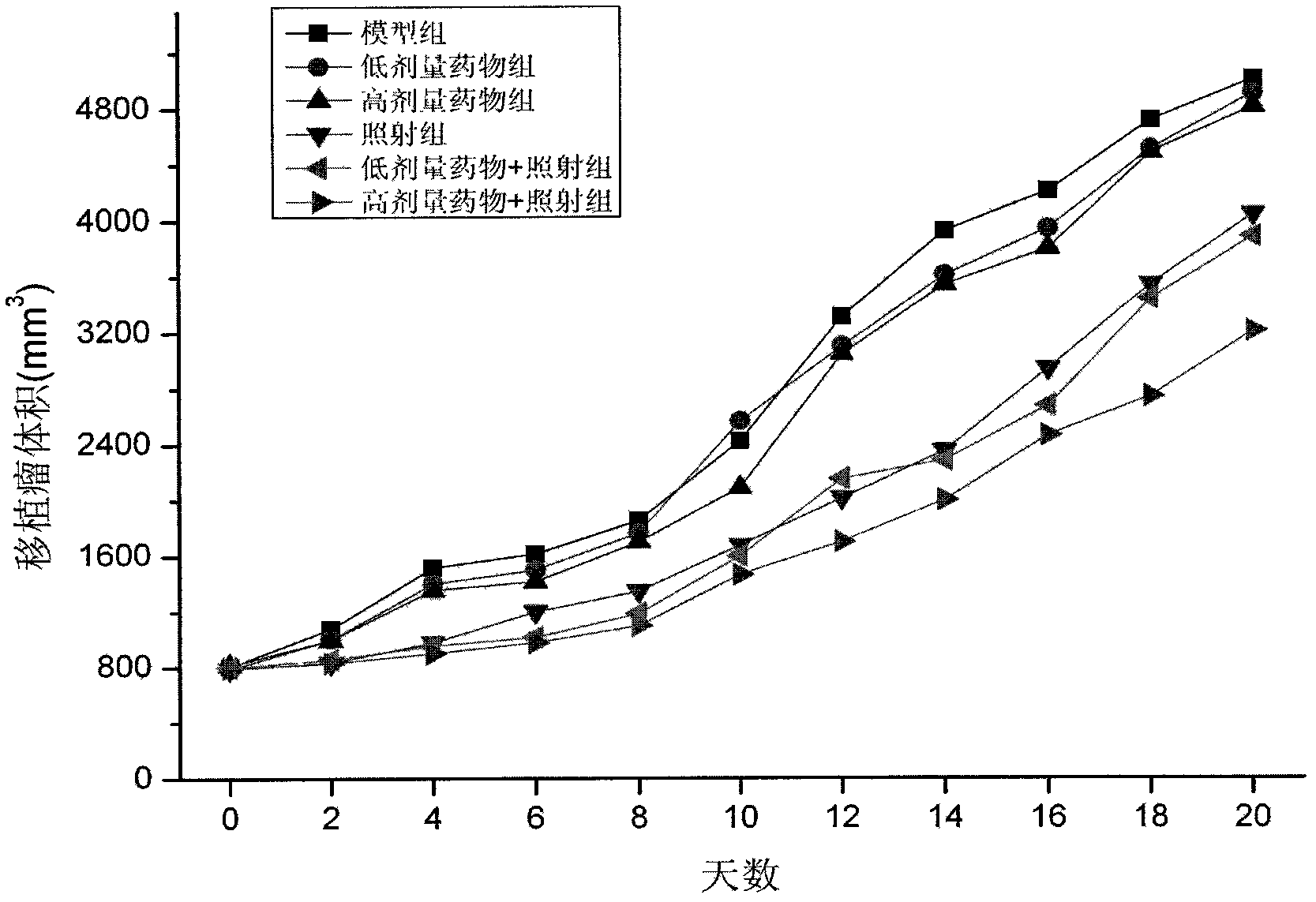Application of Paeonol in Radiosensitization of Malignant Tumors
A technology for radiosensitization and malignant tumors, which is applied in the field of new medical applications of paeonol as a radiosensitizer, which can solve the problems of high toxicity and achieve the effect of increasing the radiosensitivity of tumor cells
- Summary
- Abstract
- Description
- Claims
- Application Information
AI Technical Summary
Problems solved by technology
Method used
Image
Examples
Embodiment 1
[0020] Example 1: Effect of paeonol on the radiosensitivity of Lewis lung cancer cells in mice
[0021] 【Method】The colony formation experiment was used to measure the survival rate of cells under different intervention conditions, and the cell survival curve was fitted by a single-click multi-target model, and the relevant parameters and radiosensitivity ratio (SER) were calculated. For specific methods, please refer to references: Yin Weibo, Yu Zihao, Xu Guozhen, etc., Radiation Therapy for Tumors (Fourth Edition) [M], Peking Union Medical College Press, 2007: 234-237
[0022] [Results] See the attached results figure 1 and Table 1.
[0023] Table 1: The main parameter values of the survival curve
[0024]
[0025] The test results showed that when 5.0 and 10.0 mg / LPae were combined with radiation, the average lethal dose D0 and the quasi-threshold dose Dq both decreased, and the radiosensitization ratios SER were 1.081 and 1.164, respectively; , increased cellular r...
Embodiment 2
[0026] Example 2: The radiosensitization effect of paeonol on the mouse Lewis lung cancer xenograft model
[0027] 【method】
[0028] (1) Production of animal models: 72 C57BL / 6 mice, male, 6-8 weeks old, 20±2 grams. Prepare Lewis lung cancer cell suspension at a concentration of 1×10 7 individual / mL. 0.2 mL of cell suspension was subcutaneously injected into the right lower limb of each mouse. After 5-7 days, the experiment was started when the tumor volume increased to 800±100mm3.
[0029] (2) Grouping: 72 mice were randomly divided into 6 groups (12 in each group): model group, low-dose drug group, high-dose drug group, radiation group, low-dose drug+radiation group, high-dose drug+radiation group .
[0030] (3) Intervention conditions: irradiation dose: single 10Gy; low dose drug: 20% LD50 (156.2 mg / kg) intraperitoneal injection; high dose drug: 50% LD50 (390.5 mg / kg) intraperitoneal injection.
[0031] (4) Observation indicators: tumor volume, growth time, growth del...
Embodiment 3
[0036] Example 3: Effect of paeonol on radiosensitivity of lung adenocarcinoma A-549 cells
[0037] 【Method】The colony formation experiment was used to measure the survival rate of cells under different intervention conditions, and the cell survival curve was fitted by a single-click multi-target model, and the relevant parameters and radiosensitivity ratio (SER) were calculated. For specific methods, please refer to references: Yin Weibo, Yu Zihao, Xu Guozhen, etc., Radiation Therapy for Tumors (Fourth Edition) [M], Peking Union Medical College Press, 2007: 234-237
[0038] [Result] see the result image 3 and Table 3.
[0039] Table 3: Effect of paeonol on radiosensitivity of lung adenocarcinoma A549 cells (cell survival curve parameters)
[0040]
[0041] The test results illustrate that with 20% IC 50 Three concentrations of paeonol (2.5, 5.0, 10.0 mg / L) selected on the left and right can increase the radiosensitivity of A-549 cells after 24 hours in a dose-dependent...
PUM
 Login to View More
Login to View More Abstract
Description
Claims
Application Information
 Login to View More
Login to View More - R&D
- Intellectual Property
- Life Sciences
- Materials
- Tech Scout
- Unparalleled Data Quality
- Higher Quality Content
- 60% Fewer Hallucinations
Browse by: Latest US Patents, China's latest patents, Technical Efficacy Thesaurus, Application Domain, Technology Topic, Popular Technical Reports.
© 2025 PatSnap. All rights reserved.Legal|Privacy policy|Modern Slavery Act Transparency Statement|Sitemap|About US| Contact US: help@patsnap.com



